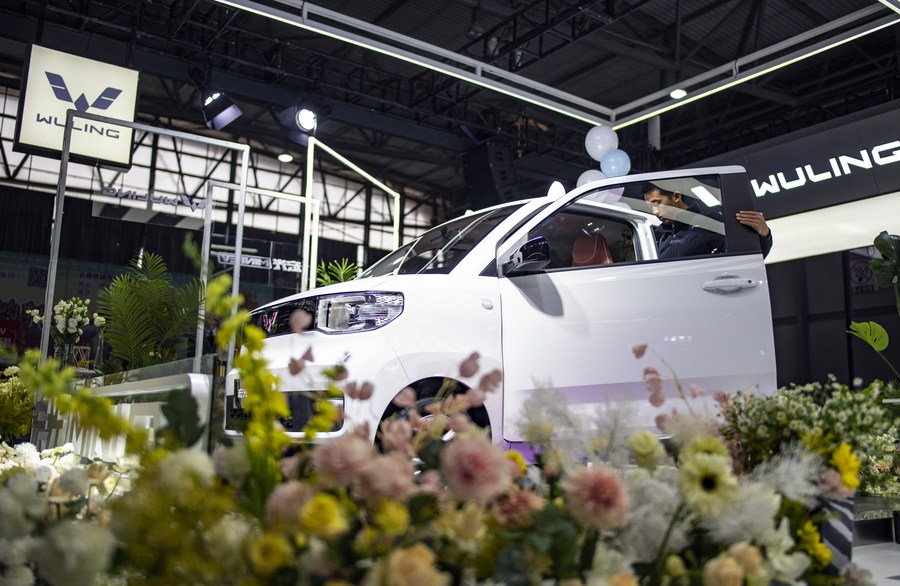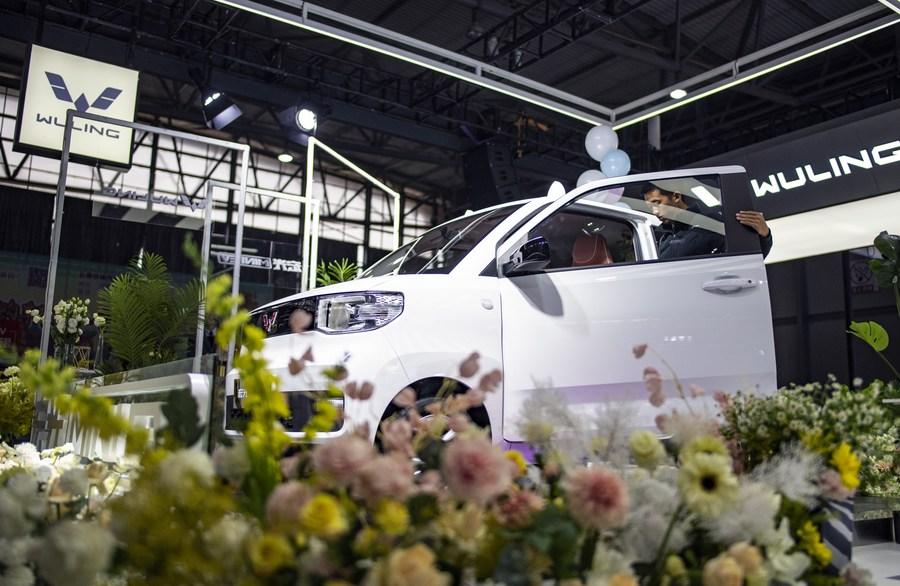
The photo taken onDec. 4, 2020 shows that avisitor looks at a new energy vehicle (NEV) during a promotional activity for NEVs in rural areas held in Kunming, southwest China's Yunnan Province. (Xinhua/Jiang Wenyao)
BEIJING, Jan. 26 (Xinhua) -- China's new energy vehicle (NEV) industry saw rapid growth in 2021, with its market share reaching 13.4 percent and annual sales of 3.521 million units, ranking first in the world for seven consecutive years.
NEVs are bestowed higher expectations with sales of 5 million units in 2022, and the NEV industry is set to remain resilient, achieve breakthroughs, and turn these expectations into reality in the new year.
In 2022, people have higher expectations for NEVs and have set a new sales objective of 5 million units. The NEV industry is set to remain resilient, achieve breakthroughs, and turn these expectations into reality in 2022.
--Making breakthroughs in the mid-end market
China's monthly NEV sales exceeded 200,000 units from March 2021. In August, November, and December, the sales reached over 300,000 units, over 400,000 units, and 530,000 units respectively.
After more than a decade of development, favorable policies, enterprises innovation and customers' recognition all have formed the synergy for NEVs' progress. Expanding product lines, sophisticated core technologies, customers' greater acceptance as well as intelligent network have contributed to the stride of the NEV industry, according to Fu Bingfeng, executive vice president and secretary general of the China Association of Automobile Manufacturers (CAAM).
The expanding product line is a crucial reason for a new sales record. "In China's auto market, abundant NEV models can cover all the traditional fuel-powered vehicle models", said Ouyang Minggao, a member of the Chinese Academy of Sciences.
The most commendable and characteristic small electric car with notable advantages over fuel-powered cars can meet the needs of customers in all aspects, Ouyang added.
The models represented by Wuling Hongguang Mini EV have boomed the low-end market, while other enterprises such as Tesla and NIO have driven customers' enthusiasm for high-end NEVs.
NEVs have opened up both high-end and low-end markets with remarkable sales. However, in the mid-end market which is supposed to have the highest share of sales, NEVs have been slow to achieve significant breakthroughs. This hourglass-shaped consumption structure contradicts the spindle consumption structure of the traditional auto market due to the difficulty of market penetration.
"The mid-end market represented by A-segment cars is the most challenging for enterprises", said Xu Haidong, deputy chief engineer of CAAM.
High-end NEV customers are less sensitive to price while the models targeting the low-end market provide different driving ranges according to various needs to balance the price. In mid-end market, consumers are more concerned about cost performance and car models shall not come at the expense of driving range, which means these cars are hardly able to compete with fuel-powered cars in cost performance.
However, the mid-end market is the primary consumer market for many products, especially consumer commodities like automobiles, and also the key element of maintaining NEVs' high-speed growth. Middle and small-sized cities and rural areas will become the booming NEV market and the essential part of market growth as electric cars are developing fast.
In 2022, Xiaomi, Niuchuang, EEZI, Heziqiche and other companies also joined the automobile industry, with nearly a total of 90 electric car models to be launched in this year, marking a fruitful year for NEVs. When the NEV market turns more competitive, breakthroughs are expected to be achieved in the mid-end market.
--Relieving charging shortage
NEVs' rapid development entails available products and an improving environment for usage. After in-depth technological breakthroughs, the holding number of NEVs grew fast, and consumers' "range anxiety" has turned into "charging anxiety".
"The problem of finding a charger" has hurdled the rapid development of NEVs.
Currently, a total of 7.84 million NEVs in China account for 2.6 percent of the total number of China's vehicles and about half of the global NEVs, but according to the latest data released by the National Development and Reform Commission, there are 810,000 public charging piles across China, of which more than 70 percent are in the top 10 regions, such as Guangdong Province and Shanghai while charging infrastructures in counties, towns and villages are insufficient. There are 13,800 charging piles on the expressways, mainly in Beijing, Tianjin, Hebei, Shandong, the Yangtze River Delta, the Pearl River Delta, and other regions, not yet fully covered.
The expansion of China's NEV market has made new requirements for the allocation of charging layout and charging efficiency to meet the customers' needs for better convenience, which entails joint efforts of the government, auto enterprises and charging pile manufacturers, according to Zhu Huarong, rotating chairman of CAAM and president of Changan Auto.
Policies have also been issued to support the construction of NEVs' supporting infrastructure. On January 21, the National Development and Reform Commission and other departments issued two guidelines to abolish restrictions on the purchase of NEVs in many places, boost the standardized and orderly development of charging facilities and accelerate the construction and installation of charging facilities in residential communities.
A guideline suggests that by the end of the 14th Five-Year Period, China's charging capacity for electric vehicles will be further improved to meet the needs of over 20 million electric cars.
In 2022, the Ministry of Industry and Information Technology (MIIT) will speed up the construction of charging and battery replacement infrastructure and continue to roll out the NEV sales in rural areas and the NEV battery replacement pilot program, according to Guo Shougang, deputy director of the No. 1 Equipment Industry Department of the MIIT.
--Improving cost performance
With the requirements for terminal consumption clearer, some factors affecting NEV sales are changing such as fewer NEV subsidies, increasing raw material prices, new insurance policies, and less favorable policies for after-sales service which all have become the "variables" in the NEV market.
Increasing raw material prices and fewer subsidies have largely increased the purchase costs in the short term. Related departments issued a guideline that in 2022, the NEV subsidies shall be cut by 30 percent from 2021. Many NEV manufacturers immediately raised car prices, some by the reduced part of subsidies, and some by the increased costs of raw materials as well, with the highest price increase up to 20,000 yuan.
China's ever-expanding NEV market will undoubtedly lower the costs, so this round of price increases will not last for long, claimed Cui Dongshu, secretary general of the China Passenger Car Association.
Automotive enterprises hold optimism about the declined subsidies. Only when products are making profits can commercial and sustainable development be truly realized, added Zhu. The year 2022 is the last year for the implementation of NEV subsidies, and when the subsidies are fully phased out, the market will become more competitive.
Insurance reforms and fewer after-sales services may increase consumer expenses. On December 27, 2021, the first batch of exclusive NEV insurance products was officially launched on the NEV insurance trading platform. According to Tesla owners, after buying the exclusive NEV insurance, they have to pay more premiums up to 80 percent higher for Tesla Model Y.
At present, automotive enterprises have adapted to the new insurance system. When the premiums remain the same or decrease, customers will be provided with services better adapted to the NEV models, according to a responsible executive of Weltmeister.
The increased NEV premiums may hinder the promotion of NEVs if customers find it difficult to afford, said Cui. He suggested that auto enterprises could establish their own car insurance policies and make more accurate calculations, and the government should provide reasonable premium subsidies.
New "variables" will not change the overall trend. Multiple agencies, such as CAAM, estimate that China's annual NEV sales will exceed 5 million units by 2022, three years ahead of schedule to achieve the target, which also shows that the development of China's NEVs will be far faster than expected.
(Edited by Tian Shenyoujia with Xinhua Silk Road, tianshenyoga0524@163.com)




 A single purchase
A single purchase









